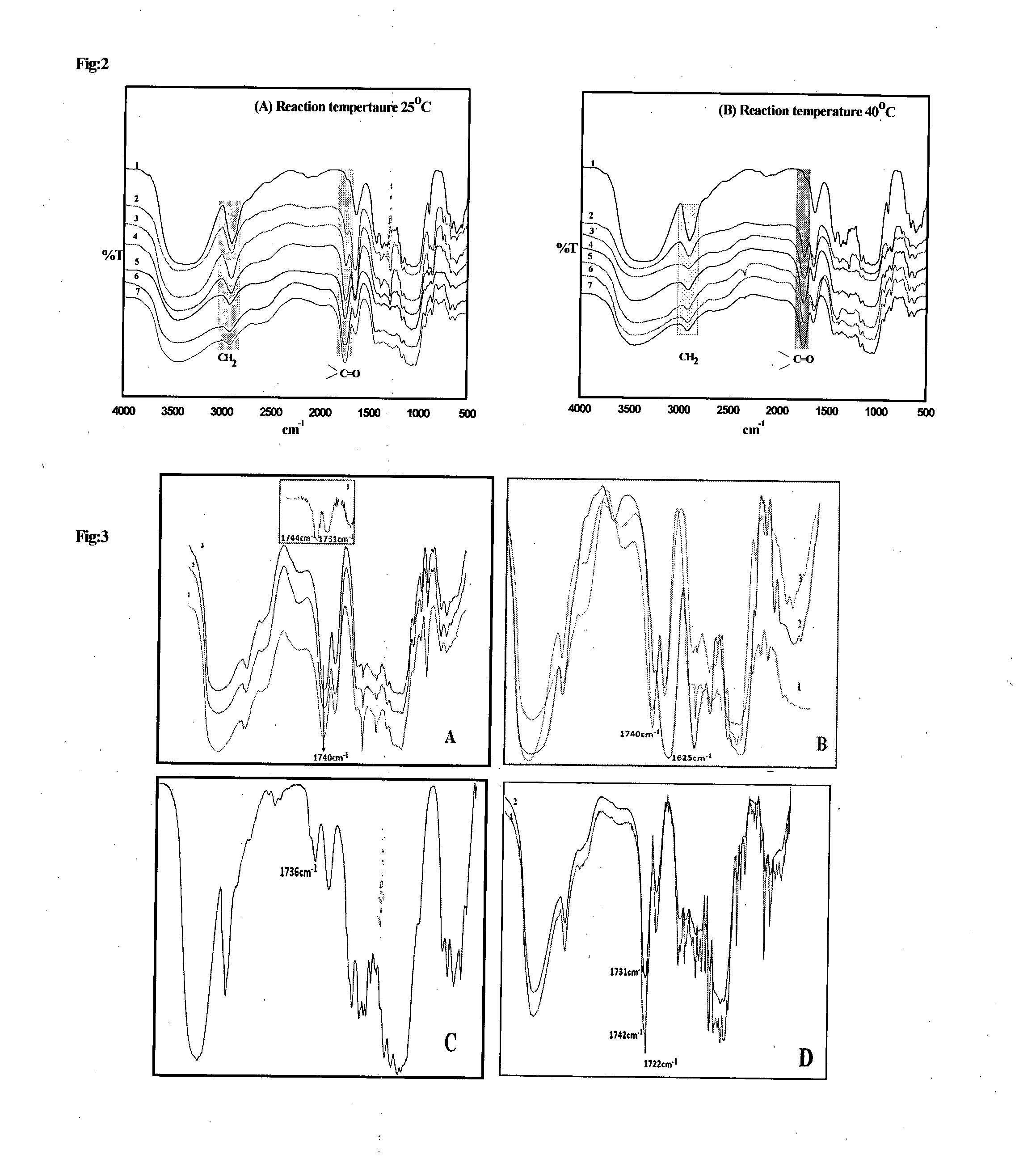Synthesis of Nanostructured Carboxycelluloses from Non-Wood Cellulose
a technology of spherical carboxycellulose and nanostructured cellulose, which is applied in the direction of biocide, cellulosic plastic layered products, natural mineral layered products, etc., can solve the problems of insufficient specificity of reaction, high molecular weight wood material takes a long time to get replenished, and cellulosic compounds have never been reported to be effective against bacterial species, etc., to achieve high carboxy content and high yield
- Summary
- Abstract
- Description
- Claims
- Application Information
AI Technical Summary
Benefits of technology
Problems solved by technology
Method used
Image
Examples
examples
Materials
[0122]Sugarcane bagasse cellulose containing ˜94% α-cellulose and 0.08% residual lignin was prepared a method developed by us. The sugarcane bagasse was provided by Godawari Sugar Mills, Sameerwadi, Karnataka. The details are in the patent (A. J. Varma, China Patent ZL 200880111416.3, dated 9 Jan. 2013
Chemicals
[0123]Analytical grade nitric acid (65%), ortho-phosphoric acid (85.0%), sodium nitrite (98.0%), and calcium acetate (99.0%) were procured from Thomas Baker, Mumbai, India. Sodium metaperiodate (99.5%), sodium thiosulphate (99.5%), and sodium bicarbonate (99.5%) were obtained from S.D. Fine Chemicals, Mumbai, India. Soluble starch (Merck), sodium hydroxide, methanol GR grade, potassium iodide and potassium dichromate were purchased from Rankem, Mumbai, India. All chemicals were used without further purification.
Example: 1
Preparation of 6-Carboxy Cellulose (6CC)
[0124]Cellulose (10 gm) was taken in a 2-neck round bottom flask, equipped with overhead teflon stirrer. 140 ...
example
Solubility Studies in Organic Solvents
[0135]The solubility of all oxidized samples was checked in 1% w / v in several organic solvents (Table 4). The higher oxidized 6CC (22%) was partially soluble in DMSO while all the TCC samples were completely soluble in DMSO. Further, TCC was also shows soluble in DMAc on heating. Similarly, [6C2, 3DAC] was soluble in acetonitrile on heating. TCC also swelled in several solvents like dioxane, acetone, ethanol and methanol. The solubility or swelling of oxidized celluloses in several organic solvents can lead to their facile transformation by a variety of organic chemical reactions and result in several new products.
TABLE 5Solubility of carboxycelluloses in organic solventsSolvents22%15:1525:1515:515:96C-Sr. No.(1% Soln.)6CCTCCTCCTCC2,3DAC1CH3CN−−−−−−−−+2DMAc−−+++−−3DMSO±++++++−−4Dioxane−−(S)(S)(S)−−5Acetone−−(S)(S)(S)−−6Methanol−−(S)(S)(S)−−7Ethanol−−(S)(S)(S)−−8CHCl3−−−−−−−−−−9DCM−−−−−−−−−−10THF−−−−−−−−−−11Toluene−−−−−−−−−−12DMF−−−−−−−−−−13Pyrid...
example 9
Antimicrobial Activity of Carboxycellulose Against E. Coli
[0137]The % inhibition determination of oxidized cellulose for E. coli-DH5 alpha via OD measurement at ˜1×106 cfu.
[0138]The percent inhibition of 6CC, 6CC-NP, TCC, TCC-NP was determined for E. coli-DH5 alpha, ATCC 67874. E. coli strain were streaked onto the appropriate media and incubated overnight at 37° C. Single colonies were selected and inoculated into 10 ml of sterile broth. Inoculated broth was incubated at 37° C. overnight under constant agitation. Overnight cultures were diluted 1:100 and 1:1000 in broth, resulting in 1×106 and 1×107 cfu, as confirmed by plating serial dilutions. A mass of 0.1, 0.5, 1.0, 2.0, 3.0, 4.0 mg of each sample were re suspended in LB broth-HIMEDIA to achieve a concentration of 1 mg / ml and autoclaved at 121° C. for 15 minute. The 198 μl of diluted samples were distributed to the first five well of a 96-well plate (the experiment was performed in triplicate). Next, three and two well of ster...
PUM
| Property | Measurement | Unit |
|---|---|---|
| temperature | aaaaa | aaaaa |
| size | aaaaa | aaaaa |
| particle size | aaaaa | aaaaa |
Abstract
Description
Claims
Application Information
 Login to View More
Login to View More - R&D
- Intellectual Property
- Life Sciences
- Materials
- Tech Scout
- Unparalleled Data Quality
- Higher Quality Content
- 60% Fewer Hallucinations
Browse by: Latest US Patents, China's latest patents, Technical Efficacy Thesaurus, Application Domain, Technology Topic, Popular Technical Reports.
© 2025 PatSnap. All rights reserved.Legal|Privacy policy|Modern Slavery Act Transparency Statement|Sitemap|About US| Contact US: help@patsnap.com



